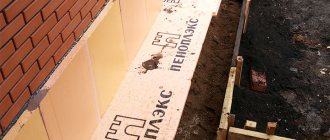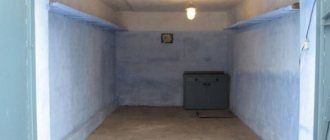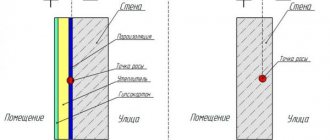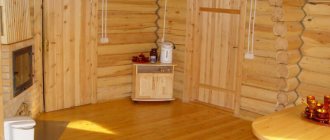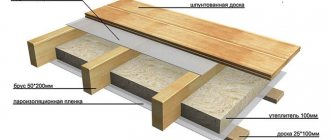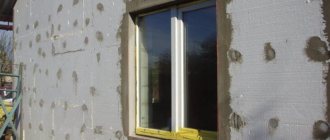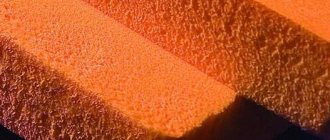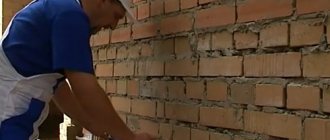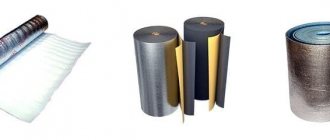With the arrival of warmer weather, construction work always intensifies. And the first thing you should think about in order to ensure warmth and comfort in your home is insulating the foundation with polyurethane foam. It's no secret that the foundation is the foundation of the house, from which it most often smells cold and damp. This measure is extremely important and it determines the thermal insulation characteristics for the entire building. The better the insulation is done, the more comfortable it will be to live in the house.
The process of insulating a building must be planned as early as possible - even at the construction stage. Only in this way will it be possible to maximize the thermal insulation characteristics of the building, making it warm, dry, modern and comfortable for living. It is advisable that work of this nature be carried out by experienced specialists.
Is it possible to independently insulate the PPU foundation?
Many, wanting to save money, would like to insulate the foundation themselves. This action can be performed independently and is not so difficult, but for this in practice you will need to have special equipment, tools, materials, and, of course, work skills. The insulation of the base using polyurethane foam occurs by spraying it, so the tools must be definitely adjusted before starting work. This method of applying the material allows you to perform thermal insulation of the foundation or base without joints, cracks or noticeable seams.
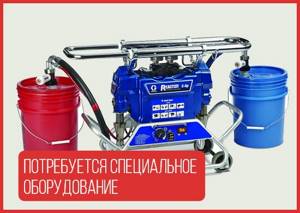
The average lifespan of spraying is about forty years, and the percentage of heat retention is approximately 97%. If you have minimal knowledge of how polyurethane foam insulation works, the necessary equipment and tools can be rented, but their cost can be quite high. In addition, special clothing will be necessary, which will prevent polyurethane foam from getting on human skin.
Characteristics of polyurethane foam
Plastic polymer masses, which are foamed to obtain a porous structure with a low thermal conductivity coefficient, are obtained on the basis of several types of polymers. Hence the common name - polystyrene foam. One of these polymers is polyurethane, which is used in construction both in the form of slabs (outwardly very similar to expanded polystyrene) and in the form of foam sprayed onto surfaces using special equipment.
Kinds
Slab insulation is much more convenient to use, since it does not require spraying equipment. In addition, PPU slabs can be used where foam cannot be used - for example, under a concrete floor laid on the ground. It is not used under slab foundations, because even with a higher density than EPS, its compressive strength is insufficient.
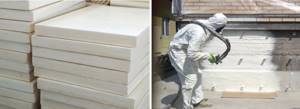
Slab and foam polyurethane
- In terms of other characteristics, polyurethane foam outperforms its main competitor and has a lot of advantages. This includes minimal moisture permeability and inertness to chemical influences. The degree of fire safety can be the same (flammability group G4), but due to the addition of fire retardants it can also be G1 (non-flammable).
- But most importantly, the thermal conductivity coefficient is only 0.028 W/m*C, which is 25-30% less than that of EPS. This means that the thermal insulation layer will be thinner to ensure the same thermal resistance, which compensates for the higher cost of the coating.
- Polyurethane in the form of foam is used to insulate external surfaces - or horizontal ones, but indoors. This coating is effective due to its seamlessness and is applied faster, but you have to pay for the services of specialists no less than the cost of the material itself.
- For this reason, the demand for work with spraying equipment is not too high, and manufacturers who have accumulated sufficient experience in the production of rigid polyurethane foam began to supply the market with the material in slab form. The owner of a private property can install it himself, and thereby save money. Accordingly, the demand for polyurethane foam insulation (the most effective compared to any other insulation) has increased significantly.
- The raw materials for polyurethane foam are materials with a cellular structure, homogeneous throughout the entire volume, polyisocyanate and polyol. The cells are closed, which ensures vapor tightness. The components are brought to a liquid state and poured into molds, where they are foamed. The mass expands, creating a certain pressure, and after 20-25 minutes it hardens.
Expert opinion Vitaly Kudryashov builder, aspiring author
Ask a Question
To expand the scope of application, manufacturers produce boards in a shell made of kraft paper or fiberglass, with one-sided or double-sided foil. In addition, these layers provide excellent protection from ultraviolet radiation and double the strength and service life of the slabs. To obtain thermal insulation coatings without through joints that would need to be sealed, PPU slabs are often produced with a quarter at the ends.
Advantages and disadvantages
Here's how you can briefly outline the list of advantages and disadvantages of polyurethane foam as insulation for the foundation:
| Advantages | Flaws |
| It does not absorb moisture, so it can come into contact with moisture-saturated soil without compromising its strength. | High price. One square meter costs at least 300 rubles. And the foundation tape needs to be insulated to a thickness of at least 100 mm - in two or three rows. It’s not difficult to calculate how much such pleasure will cost. |
| In fact, it is also a waterproofing material. | There is not enough compressive strength to insulate the base of a slab foundation. |
| During installation, you can create a seamless coating with sealed joints. | It interacts poorly with ultraviolet radiation - but being in the ground, it is protected from it. When insulating the basement part, the polystyrene foam is covered with finishing - plaster or hanging panels. |
| Resistant to aggressive salts dissolved in groundwater. | Susceptible to damage by rodents, for protection it is lined with geotextiles or covered with a PVC membrane. |
| The surface is not subject to cracking. | |
| It serves for a long time without changing its original properties. | |
| Withstands high loads without being damaged mechanically. | |
| The slab form makes it possible not only to insulate the walls, but also the floors of the basement, and this can be done in a short time. | |
| Compressive strength not less than 0.12 MPa. | |
| It is not afraid of temperature changes, and can work at 70 degrees, both above and below zero. | |
| Using the spraying method, you can insulate a foundation with a complex configuration and without seams. | |
| Long service life: for ordinary boards 20 years, for laminated boards - up to 60 years. | |
| Easy installation. | |
| Light weight. | |
| PPU is universal and can be used for both external and internal insulation. | |
| Fireproof, in the absence of open fire it goes out on its own. |
How to insulate polyurethane foam yourself?
Like other construction work, this type of thermal insulation must be carried out in stages.
- Some preparation. If these are walls or the side of the foundation, it is necessary to clean them of the previous coating and crumbling parts, including plaster and paint.
- For the base it is necessary to make a sheathing. This must be done only from blocks of wood or metal profiles. The thickness and size of the guides should be selected depending on the layer of insulation that will subsequently be applied to the surface. The lathing will serve not only as a frame, but also as a leveling for the foundation. It must be mounted on the side surface plumb and level.
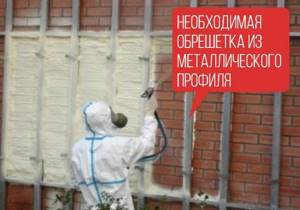
- Next, foaming polyurethane foam is sprayed onto a pre-prepared surface using special equipment - a gun.
- Remember that the intensity of spraying is also adjustable. A thicker stand is not always necessary. Therefore, it is worth adjusting the gun so that the spray occurs in thin jets, but the sheathing for a thin layer of insulation should be made of thin profiles or beams.
- You need to start the spraying process from the ground and apply layers between the elements of the sheathing made.
- Remember that the material foams, so it must be applied in a thin layer, which will later gain volume. If it seems to you that the already foamed layer is not enough, you can apply another one on top of it.
- After the polyurethane foam has hardened, it is necessary to level the surface. To do this, all the same actions are done as with polyurethane foam, which is familiar to many. That is, the protruding relief is simply cut off along the frame guides.
- For an aesthetic component, you can cover the surface with plaster or paint, but only on top of a thin layer of cement mortar.
Sequence of actions and application technology
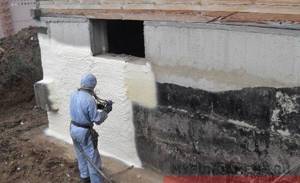
A responsible approach to the task will require some additional actions, taking into account the important nuances of the polyurethane insulation technology and compliance with the sequence of work.
- The foundation is dug around the entire perimeter with an indentation of 0.7–1 m.
- The surface should be cleaned of dirt, dust, stones, soil residues should be removed, and loose concrete should be removed. There is no need to level and fill cracks with mortar if the unevenness is insignificant. The structure of polyurethane foam allows it to adhere well to the prepared surface and fill in recesses and cavities. However, you should not apply it to wet foundation walls: if the underground part is wet, you should wait until it dries.
- Despite the versatility of polyurethane foam (in addition to insulation, it also has good moisture-proofing properties), experts still recommend that for 100% protection against moisture, treat the surface with bitumen mastic (waterproofing material), and in 2 layers.
- The components of the PU foam system are combined in the proportions specified in the technical data sheet for the spraying device. Using equipment, the first layer is applied, no more than 2 cm thick. Spraying occurs from top to bottom: to ensure waterproofing (protecting the foundation from the effects of melt water), about 40 cm of the above-ground part and the entire underground part of the foundation are captured.
- After mixing the foam in containers after a break in work, after stabilization (hardening), the next layer is applied. 3 layers are enough. Although instead of 3 x 2 cm, specialists can apply evenly one layer of 5 cm. If stronger protection is required, the width of the insulation can reach 10 cm (in 2 layers). The consumption in the first case will be less: only 1 kg per square meter. m.
- The service life of polyurethane foam can be increased: after the polyurethane foam layers have dried, the excavated soil is filled in and concrete is poured on top (blind area). This stage of work should be completed no earlier than 3 days after applying the foam.
As a result of the work performed, a seamless and reliable insulation is formed that insulates moisture. Problems during the spraying process (foam dripping, its heterogeneity, the appearance of cracks) can arise due to bad weather conditions or inattention to the standard dosages of the components. For example, cracks form at low temperatures in the external environment, on the work surface and even in containers with foam. They should be eliminated promptly.
How much will it cost to order a team to insulate the foundation of a substation?
If you listened to our advice and decided that thermal insulation of the foundation is still the work of a master, then you are probably wondering how much you will have to pay for this service. The total price for insulating a polyurethane foam foundation will depend on the quality of the material itself, the thickness of the required layer, as well as the size of the base that needs to be insulated. In addition, the region in which the work will be carried out also plays a fairly important role. Thus, ordering a team to carry out thermal insulation of the foundation can cost from 143 to 570 hryvnia per cubic meter.
It is optimal to choose the middle price category. It is worth carrying out thermal insulation with materials that have the highest thermal conductivity coefficient, are not afraid of dampness and moisture, and are also resistant to the influence of an aggressive external environment. This is exactly what rigid polyurethane foam is.
We take into account the features of the technology before starting work

The technology of spraying polyurethane foam is suitable not only for insulating the foundation, but also the base, walls, roofs and floors. If a basement is planned, both external and internal insulation is recommended. Masters of their craft offer interior work when it is not possible to work as a “sprayer” from the outside. External is done around the entire perimeter. A layer of 6 cm can be considered reliable.
PPU has its own temperature threshold - +5 C. Therefore, you should not plan work for late autumn and winter. It is not worthwhile to insulate with this building material during rain and strong winds (more than 5 km/h).
To carry out the work you will need raw materials and a foam generator. To thermally insulate the foundation, it is enough to choose rigid polyurethane foam (with a density of 32 kg/cubic m). Bitumen mastic is useful as additional waterproofing.
Conclusion
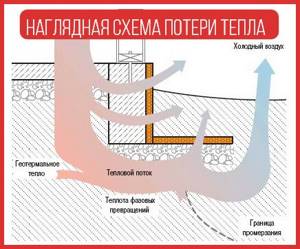
The basement always needs thermal insulation, because it is the conductor of cold from the ground and soil. Any work that is related to thermal insulation, as well as construction, has two main, fundamental criteria: the quality of the material that is used in itself, knowledge, experience and, of course, the attentiveness of the master. That is why it is best to entrust this task to a trusted specialist or company who can do everything quickly and efficiently, and at the same time share useful tips for further work.
How to spray polyurethane foam
Due to their lower thermal conductivity, polyurethane foams have a huge advantage over expanded polystyrene foams. Although, since EPS is cheaper, there is always the opportunity to increase the thickness of the insulating layer. However, in some cases it is better when the thermal insulation is thinner, and this can be achieved by insulating the foundation by spraying polyurethane foam. For example - under hanging cladding.
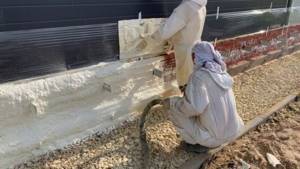
Insulation of the base under the cladding
- This coating is very useful when it is necessary to insulate foundations with an intricate contour. In such cases, cutting and gluing the slabs is a hassle, and the many joints that are not always even are quite difficult and labor-intensive to seal. Foam insulation solves all problems at once. When the layer thickness does not exceed 2-3 cm, a large indentation is not required for cladding.
- The advantage of sprayed insulation over slab insulation is that when it is applied, no voids are formed between the base and the foam. This means that moisture cannot enter them, and visually undetectable cold bridges will not form. Foam can be applied to a base of any quality, even with a large number of differences, whereas for insulation with slabs they would first need to be leveled with cement glue.
- In general, in situations where the integrity of the insulation layer is difficult to control (especially on older buildings), it is better to use a spray method that will fill every hole and joint. Sprayed thermal insulation is also most relevant for buildings with a large foundation area (more than 100 m²).
- It is difficult to guarantee high-quality sealing of slabs in such areas, but in the case of foam insulation, the guarantee is one hundred percent. In addition, large volumes of work make it possible to get a discount of up to 15%, so it may well turn out that you will still win.
The savings are obtained not so much due to the cost of services and materials, but due to the reduced time frame for completing the work. Spraying is usually carried out by teams of two people, and in one work shift they can treat an area of up to 500 m². You don’t have to wait long for the foam to polymerize either (only a few hours). And time, as you know, is also money.
Equipment configuration
Sprayed insulation is mixed from two components. They are delivered to the facility in different containers: blue barrels contain polyol, red barrels contain isocyanate.

PPU system components
The installation, through which spraying is carried out, has the following equipment:
- A pressure compressor that provides the required pressure.
- A mixture preparation mechanism consisting of a pair of pumps and a remote control. With its help, the components are mixed and heated to the temperature specified by the manufacturer.
- Flexible pipeline with a dispensing gun and replaceable nozzles (differing in the type of spray torch).
- Technical silicone, which is used to lubricate the gun seating area.
- Equipment assembly tool.
- Protective clothing.
For normal operation, the compressor requires electricity, and not 220, but 380 volts. At new construction sites there is often no permanent network at all - and even if there is, it is not suitable for the operation of the spraying unit due to frequent power surges. Professional teams are also equipped with a diesel generator, although it is not included in the equipment package.
Expert opinion Vitaly Kudryashov builder, aspiring author
Ask a Question
Note: PU foam manufacturers offer consumers mini-kits for applying foam themselves. If you decide to purchase one, you will have to think about buying a generator.
Foam application
The final properties of the resulting thermal insulation coating depend on several factors: the proportions of the components; air temperature and the mixture itself; the pressure at which it is supplied; thermal conductivity of the base on which the foam is applied.
The application process generally looks like this:
- The base is cleaned of all types of dirt and loose areas. If necessary, wash and dry.
- Before applying foam, some specialists treat the surface of the foundation with waterproofing coating, usually bitumen. But in principle, this operation can be omitted, since the foam itself is an excellent waterproofing agent. But priming to reduce the absorbency of the base makes sense - this way less foam will be consumed.
- The mixture, liquefied due to heating, is applied to the surface in the form of a continuous coating, or it is filled into the cells of the sheathing installed under the hanging decorative material.
Expert opinion Vitaly Kudryashov builder, aspiring authorAsk a Question
When applying foam, experience is required: the mixture expands 100 times during the polymerization process, and in order to obtain a layer of the required thickness, this must be taken into account. A layer with a thickness of no more than 50 mm is considered normal. If this is not enough according to thermal resistance calculations, you will have to apply a second layer.
- Foam is applied to the foundation before backfilling is completed. If the structures of an already in use house are being insulated, the blind area must be dismantled, and the foundation strip or basement wall is exposed by 50 cm. Where the soil freezes slightly, only the above-ground part of the foundation and the soil around the perimeter can be insulated.
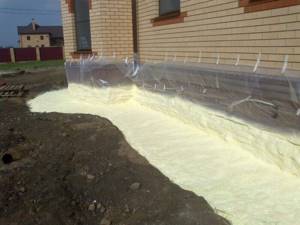
Insulation of the blind area
Subsequently, the strip, with polyurethane foam sprayed to a width of 80-100 cm, will be hidden under the covering of the blind area. It is very important to protect the already applied foam from ultraviolet radiation during polymerization, so the covering material must be taken care of in advance.
Foundation waterproofing (coating) ↑
This is used when protection from capillary moisture is needed, with hydrostatic pressure up to 0.1 MPa. The technique of coating waterproofing is simple. It is performed using bitumen or polymer mastics, which create a kind of film with waterproof properties on the foundation surfaces. As a basic protection, coating technologies are used for vertical waterproofing of foundations. When performing horizontal waterproofing with coating materials, you should remember that their strength leaves much to be desired, so they are used only as an auxiliary waterproofing layer. A small amount of mounting foam is blown into each hole and a mushroom dowel is driven in. After all this work has been done, waterproofing with polymer mastic is applied to the insulation and after it dries, the ditch can be covered with earth.
Advantages and disadvantages
pros:
- Low thermal conductivity. Insufficient insulation of the foundation and basement of the building can cause low temperatures in the premises. PPU with a layer thickness of 40 mm protects the structure from the cold in the same way as aerated concrete (600 mm thick), brick (1700 mm thick), polystyrene foam (180 mm thick), concrete (more than 1500 mm thick).
- Increased adhesion. The ability of the material to adhere to surfaces of any type (concrete, brick, wood, rubber, slag).
- Resistance to aggressive substances. The ingress of organic solvents will not affect the properties of the material and will not damage it. The polyurethane foam coating can only be removed mechanically.
- Lifetime. By preventing mechanical impact on thermal insulation made of polyurethane foam and exposure to sunlight, it will increase the service life to 50 years without loss of properties.
- Weight. Due to the low weight of the insulation, the load on the foundation is not taken into account, and there is no loss in density.
- Water resistance. PPU can be used without additional waterproofing.
- Resistant to temperature changes.
- No seams after installation. This property prevents the penetration of cold and moisture onto the surface of the base.
- Possibility of spraying on structures of any shape, universal filling of existing cracks.
- Fire resistance. The material is non-flammable. The higher the density of the raw material, the lower the flammability, which makes it possible to use it for insulation of kindergartens and schools.
- Speed of work, speed of insulation hardening. One worker insulates 150 m2 of polyurethane foam per day. With other types of thermal insulation, the performance is much lower.
- Ease of work.
- There is no need for a large area for equipment or storage of barrels with components.
- Polyurethane foam is not susceptible to the formation of mold and mildew.
- High sound insulation.
